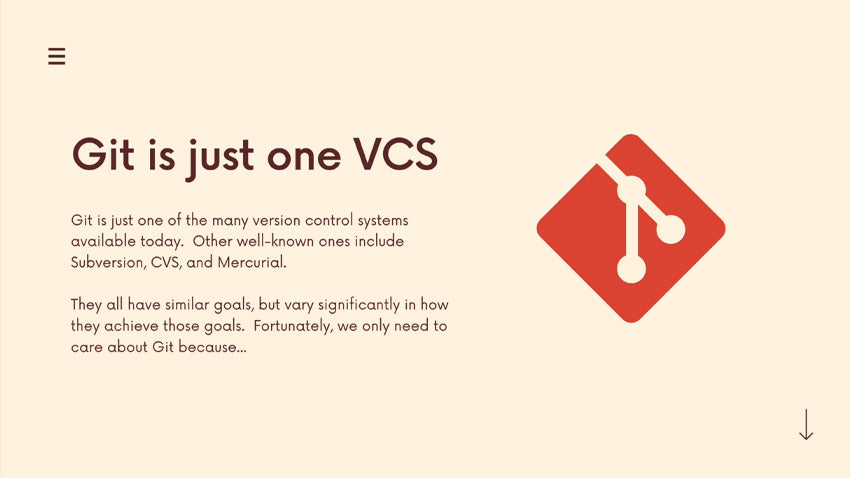82% Off The Git & Github Bootcamp | Udemy Review & Coupon
82% Off The Git & Github Bootcamp | Udemy Review & Coupon
Couldn't load pickup availability
Learn important Git concepts such as rebasing, squashing, stashing, reflogs, blobs, trees, and more to improve your skills.
This course covers:
The Git & Github Bootcamp is a comprehensive online course that covers the essential tools and skills needed to use Git and GitHub in an effective manner. It includes 17 hours of on-demand video, 1 article, 18 downloadable resources, full lifetime access, access on mobile and TV, a certificate of completion, and a 30-day money-back guarantee.
This course provides both beginners and experienced developers with the tools needed to collaborate, store code, track changes, and version control using Git and GitHub. Topics covered include branching, rebasing, squashing, stashing, reflogs, blobs, trees, and more. By the end of this course students will be able to use Git & GitHub like a pro!
What you'll learn
Git is an invaluable tool for managing version control for software projects, allowing teams to work cohesively with the most up-to-date versions of their code. Understanding how Git works behind the scenes is essential to maximize its potential efficiency and usefulness.
One unique aspect of Git is its use of special objects to track file changes over time. These objects – trees, blobs, commits, and annotations tags – store all data associated with a particular version of a project. The process of adding, committing and working with branches also needs to be mastered in order to efficiently utilize Git. Once this process has been successfully navigated, users will understand how to perform merges and resolve merge conflicts when necessary. Furthermore, using ‘git diff’ can offer insight into the ways that files have changed over time.
- Learn how to use Git stashing.
- Learn how to use git restore, git revert, and git reset to reverse changes.
- Utilize repositories both locally and remotely.
- Learn collaboration workflows such as pull requests, "fork & clone", and more.
- Perform squash, cleaning, and rewriting of history using interactive rebase.
- Retrieve "lost" work using git reflogs
- Create customized Git aliases for enhanced functionality.
- Mark utilizes Git tags for the purpose of releasing and organizing versions.
- Github Pages can be used to host static websites.
- Creating READMEs using Markdown is a helpful way to organize information.
- One way to share code and snippets is by utilizing Github Gists.
Through these tools, users get full command over their project’s history and will benefit from far more precise tracking than ever before!
About Instructor
Colt Steele is a developer who is passionate about teaching. He has worked as an instructor at two immersive bootcamps over the past few years, where he has successfully taught web development to hundreds of individuals, positively impacting their lives. The graduates of his program have secured employment at various companies, including Google, Salesforce, and Square.
He served as the Lead Instructor and Curriculum Director for Galvanize's SF 6-month immersive program. Following the completion of his class, 94% of the students secured full-time positions as developers. He was employed as a Senior Course Developer for the web development team at Udacity, where he was able to impact a large number of students on a daily basis.
He is now concentrating on transferring his experience in classroom teaching to an online format. He launched his Web Developer Bootcamp course in 2016, and it has since become a top-rated and best-selling course on Udemy. He received the title of Best New Instructor of 2016 from Udemy.
After years of research, he has developed a formula for teaching technical skills in a classroom setting and is eager to share his expertise with you. He asserts that his online courses are the most comprehensive available on the market.
Description
In the world of code, Git and Github have become essential tools for carrying out work successfully. The saying goes that "the best time to learn Git was yesterday" but fortunately, today is the second best time! This course is designed to help those who are just getting started withlearning these essential tools.
The course covers everything a student needs to start using Git and Github in the real world today. 20+ sections are broken down into four units: Git Essentials, Configuring & Initializing Projects, Working with Version Control and Collaboration on GitHubd. These sections will guide learners as they advance their skills beyond beginner-level so they can keep up with the demanding nature of code-related fields such as data science, game development and machine learning. With a little bit of self-study and dedication, students will be on their way to becoming proficient with Git and Github before they know it!
The course is divided into four units, consisting of more than 20 sections: Git Essentials, Next Level Git, Github & Collaboration, and The Tricky Bits.
Our course begins with Git Essentials. The objective of this unit is to provide you with all the necessary Git tools for your everyday tasks. The discussion begins with an explanation of version control software, its significance, and the background of Git. After installing Git, the necessary Unix commands for working with Git will be covered (this section can be skipped for those already familiar). The focus of this unit is on teaching the core mechanics of Git, such as committing and branching, along with associated concepts such as the working directory, repository, and staging area. The covered Git commands include git init, git add, git commit, git status, git log, git branch, and git merge. The final topic covered is an in-depth examination of branching, merging, and conflict resolution.
In the Next Level Git unit, we delve into additional Git commands and concepts that offer great utility, although they may not be considered core in the same way as Git Essentials. The gif diff command is examined in depth, along with the different comparisons that can be made between commits, branches, the working directory, and the staging area. We place emphasis on carefully reading and analyzing the detailed results produced by diffs. Next, we will discuss the git stash command, which is frequently utilized by Git users as a convenient addition to their workflow. The next topic to be covered in Git is the process of undoing changes and time traveling. The process includes learning how to revisit previous work, detach and reattach HEAD, as well as discarding changes. The article covers various git commands that aid in reversing changes, such as git checkout, git restore, git reset, and git revert.
Now, let's shift our attention to Github and collaboration. The first step is to examine Github and other similar tools that contain remote repositories and analyze the advantages they offer. To manage changes between our remote and local repositories, we utilize git push, git pull, and git fetch commands and create our own Github repositories. The course covers collaboration workflows commonly used in real-world scenarios, including feature branching, pull requests, forking & cloning, and other related processes. We explore the topic of contributing to open source projects and discuss the process of configuring Github repositories for collaborative work. We dedicated some time to familiarizing ourselves with useful Github features, such as Github Gists and Github Pages, which offer free static hosting.
The final unit of the course, The Tricky Bits, comprises a compilation of valuable Git commands and advanced subjects. One of the Git commands that is often perceived as intimidating is rebasing, which we will cover first. We analyze the advantages and disadvantages of rebasing and contrast it with merging. The process of cleaning up Git history involves utilizing the interactive rebase command to make changes such as rewording, editing, dropping, and squashing commits. The following topic of discussion involves Git tags, including both lightweight and annotated tags, as well as the use of semantic versioning and tagging workflows. Following that, we will delve into a comprehensive examination of the functionality of Git. The topics covered include the internal files and folders used by Git, the function of hashing functions in Git, and the importance of Git objects such as blobs and trees. The following topic of discussion pertains to reference logs and the utilization of the git reflog command. The article explains the usefulness of reflogs in recovering lost commits and undoing rebases. The topic covered was the creation of personalized and effective Git aliases.
The course contains numerous diagrams and visual aids created to facilitate understanding of Git. The course contains exercises that have been tried and tested on in-person students, allowing you to practice the course concepts during the learning process. Congratulations on reaching this point in the course. I hope you continue to find it enjoyable.
This course is intended for:
This course is suitable for anyone looking to learn the basics of Git. Whether you’re completely new to code or a veteran coder interested in brushing up on your Git skills, this course is perfect for you. It covers everything from getting started with setting up a repository to using commands and branching operations to work collaboratively with other developers.
Git is an essential tool for any person working with code, especially web developers, data scientists, software engineers, mobile developers, and game developers. This course gives an overview of basic version control principles and will teach students how to use Git effectively while handling pull requests and understanding merge conflicts. The techniques taught in this course can also be applied outside of a typical technical role; this knowledge can be useful when tracking changes made to documents or collaborating on projects with other people.
Frequently Asked Questions
What is the difference between Git and GitHub?
Git is a version control system, a tool to manage your source code history. GitHub is a cloud-based hosting service that lets you manage Git repositories. It provides other features such as bug tracking, feature requests, task management, and wikis for every repository.
How is Git different from Subversion ?
Git is a distributed version control system, meaning the entire codebase and history is available on every developer’s computer, so there is no single point of failure. Subversion is a centralized version control system, meaning that the code and history is stored on a central server.
What is the purpose of Git?
Git allows developers to work together on a project without the need to constantly update and commit files to a central server. Each developer can work independently, making changes in their own “branch”, which can then be merged into the main codebase.
What is the best way to learn Git?
The best way to learn Git is by doing it! Start off with simple tasks such as cloning a repository and creating commits. Then, slowly progress to more complex tasks such as branching and merging. You can also read up on Git concepts and commands in tutorials or online resources.
What is the “GitHub flow”?
The GitHub flow is a lightweight workflow for managing feature branches. It consists of 5 steps: create a branch, add commits, open a pull request, review code, and merge. This workflow allows developers to collaborate on code without affecting the main codebase.
What is “GitHub Desktop”?
GitHub Desktop is a desktop application for managing Git repositories. It allows developers to collaborate on code, manage local branches, and push changes to remote repositories.
Share:



In my opinion, it would have been beneficial to have exercises that cover topics such as rebasing, reflogs, and potentially a few others. The transition between Git and GitHub in the course structure was initially confusing due to the jumping back and forth, but it is understandable that certain Git features were saved for the end because they are less frequently utilized. Some ideas could have been presented more concisely, with less repetition of content. I observed that the course was approximately 20-30% longer than necessary, while still maintaining the content.
Overall, the course and teaching skills displayed by the instructor were excellent.
The course provides a comprehensive introduction to Git and GitHub version control systems (VCS). Colt's teaching style creates an immersive and personal learning experience. Additionally, he often uses personal examples from his farm animals, pets, food, and music preferences to illustrate his points. The examples provided in the course were clear and easy to replicate on my own computer. After gaining experience using VCS, I now feel confident in using them and troubleshooting when needed, despite having no previous experience.
In my opinion, the addition of exercises involving rebasing, reflogs, and other related sections could have enhanced the overall experience. Transitioning between Git and GitHub in the course structure caused some initial confusion. However, it was later understood that certain Git features were saved for the end due to their less frequent usage. There is room for improvement in the presentation of ideas, with the potential to reduce repetition and increase conciseness. Based on my assessment, the course could have been shortened by approximately 20-30% without compromising the content.
Overall, the course was excellent and the instructor displayed great teaching skills.




